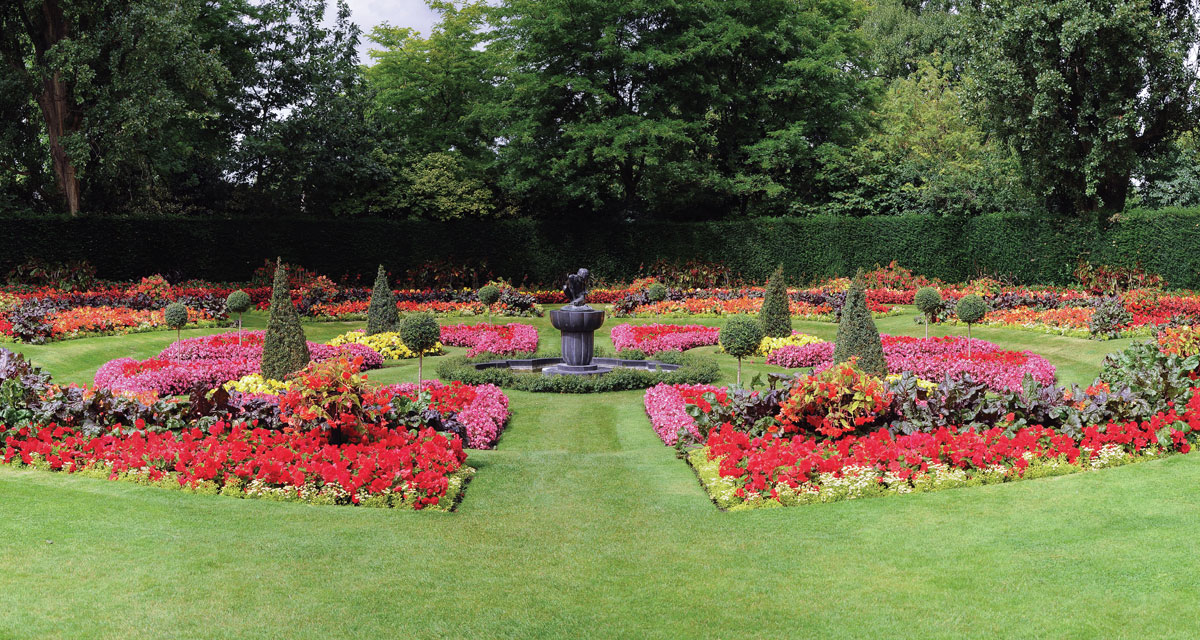“Impossible!” you may be thinking. “How could I possibly recreate an English garden in my backyard?” The concept of clean lines in a symmetrical architectural design, and pathways set by flowers or a boxwood hedge on each side, has aspects appealing to gardeners and nature lovers alike. If you have ever wanted a statue, rose garden, or a section of wildflowers, then, perhaps extracting a few or all aspects of an English garden may appeal to you more than first realized. Ready?
Create a plan!
First, think about what you would love to have in your backyard. Ideas such as designated pathways, “L-shaped” garden beds, a rose garden, a sitting area, and a pool of water may be at the top of your list; then, measure the intended space in width and length. Create a grid, such as equating one foot to one block, and then design. It is wise to start with the center, including a focal point, and branch outward. Paths, made from pea gravel, stone, or brick, should be wide and straight. Remember, you’ll want to present a symmetrical design.
Tip: Study photos of English gardens to collect ideas for your own space.
Clean Lines and Unique Shapes
Traditional English gardens are rectangular or square. In perusing pictures, we see that traditional gardens feature a low hedge, usually of boxwood, that forms “rooms” to define space. Although that is a great choice, consider spacing the shrub to offer an open and spacious look. Another option to enhance the background or create a wall is to add tall flowers, such as Lavender, coneflowers, delphinium, or roses.
Tip: By planting different shrubs together, limbs can weave in and out to form a tapestry effect. Consider marking your corners, perhaps in an “L-Shape” to impose defined lines, and maintain the shape.
Bright and Colorful Plants
Arrangements of bright and colorful flowers not on ground level, but raised or elevated, add abundance and warmth to a location, whether large or cozy. A trellis or arbor are options. Rather than mow, consider planting a variety of groundcovers, creeping thyme, heat-resistant ornamental grasses, or allowing nature to take over and planting wildflowers.
To design arrangements, especially against a fence or border, use string to mark each growing variety; for instance, by placing three to five-foot tall flowers in the back, one-foot to three-feet-tall ones in the middle, and 14-to-18-inch plants along the front. Selecting plant varieties is an essential step in designing a garden. While the height variation is vital, also consider each plant’s soil, light, and especially, water requirements. For instance, lavender would not flourish next to a plant, such as day lilies or iris, which thrives in moist soil.
If you are looking for color themes to blend or contrast, reference the following list. Please note: flowers are not listed multiple times to accommodate the variety of colors.
Green: ferns, lady’s mantle,
Orange: day lilies, Gaillardia aristate
Pinks: bleeding hearts, Dianthus, peony
Purples/Blues: Aster, coreopsis, delphinium, hyacinth, hydrangea, iris, lavender, lobelia, lungwort, purple coneflower, Russian sage, salvia, sedum, speedwell,
Red: astilbe, bee balm, canna, coral bells, hibiscus, Indian blanket flowers,tulips, roses,
Yellow: Calla lilies, cosmos, chrysanthemums,black-eyed-Susans, daffodils, Dutch Iris, phlox, snapdragons, tickseed,
White: carnation, foam flower, gladiola, Shasta daisy, yarrow.
Tip: Add your favorite herbs to compliment your garden and promote the arrival of pollinators. At the end of the season, herbs help the most glorious flowers reach surprising heights.
Tip: Add spring and fall bulbs to enhance the growing season and extend color throughout the year.
Focal Point
In designing an architectural space of lines, the eye will need to rest on one single object or focal point. It can be a colorful vase or pot resting on a pedestal, or a tall concrete stand surrounded by flowers. You’ll instantly know when the right object well suits the scale of the garden, and offers balance. To create sharp visual lines, consider placing the focal point aligned with a door or path.
While designing an English garden favors symmetrical design, be creative! The garden will reflect your unique personality and needs. Add a bench, birdhouses, birdbaths, and enjoy!




















